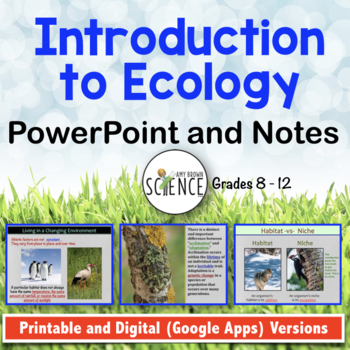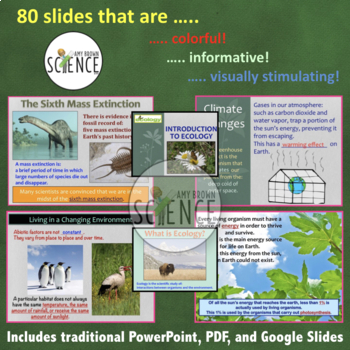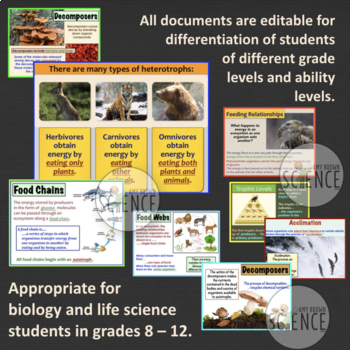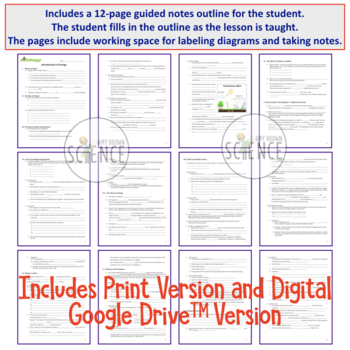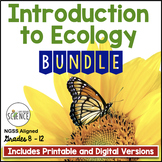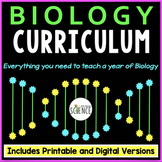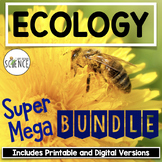Introduction to Ecology PowerPoint and Notes
- Zip
- Google Apps™

What educators are saying
Also included in
- In this Ecology Bundle, students will learn about habitats and niches, biotic and abiotic factors, the greenhouse effect and ozone depletion, food chains and food webs, levels of ecological organization, climate zones, and so much more. See complete list below. PRINTABLE, EDITABLE, DIGITAL.In short,Price $31.75Original Price $40.99Save $9.24
- This NO PREP, PRINTABLE, EDITABLE, AND DIGITAL Biology Curriculum contains everything you need for an entire year of Biology! For less than $3 a day, you can save your time, energy, and sanity. Each of the 20 Complete Units includes a teaching PowerPoint presentation, notes, labs, homework assignmenPrice $525.00Original Price $988.18Save $463.18
- All of my ecology and environmental science resources (6 ecology unit bundles) are included in this one Super-Mega-Bundle! This mega-bundle includes all of the PowerPoints, notes, labs, task cards, homework assignments, review games, quizzes, activities, and unit tests that you need to teach a compPrice $178.00Original Price $252.64Save $74.64
Description
This colorful and engaging PowerPoint presentation, "Introduction to Ecology", will provide your students with interactive lessons on the fundamental principles of ecology. Choose to use the traditional printable version, or the paperless, digital Google Apps version. Ecology is one of the "must-teach" topics for any biology or life science class. The ecological inter-relationships that occur in nature are essential to an understanding of our world and how life interacts with the physical environment, as well as with other living organisms. Ecology topics, such as global warming, ozone destruction, greenhouse gases, and habitat destruction, dominate the news. We must make sure that our students are knowledgeable in these topics so they can be informed decision makers in the future.
What is Included in this resource?
- 80-slide PowerPoint presentation (Includes traditional PowerPoint, PDF, and Google slides)
- Editable and Printable 9-page set of lecture notes for the teacher
- Editable and Printable 12-page guided notes outline for the student
- Paperless Digital Version for use in Google Drive, Google Classroom, and /or Microsoft OneDrive
There is so much material to teach in a unit on Ecology that it can be overwhelming. When I teach ecology, I divide the information into 6 separate units of instruction. This introductory PowerPoint introduces the basic principles of ecology. These principles are covered in more detail in the later lessons.
4. Ecosystems and the Biosphere Part 1: Energy Flow and the Recycling of Matter
5. Ecosystems and the Biosphere Part 2: Biomes of the World
6. Human Impact on the Environment
Please Note: This resource is just for the first topic of instruction: Introduction to Ecology.
This PowerPoint, "Introduction to Ecology" consists of 80 slides that are colorful, informative and visually stimulating. Pictures and diagrams are included that will greatly enhance your instruction to your students. This product also includes a set of notes for the teacher (9 pages) and a guided outline of the notes for the student (12 pages). Graphics, diagrams, clip art, and photographs were chosen to capture the attention of the student as the lesson is being taught. Students will use the outline as the PowerPoint is being presented and will fill in the notes as the lesson is being taught. I always include both the Word document and a pdf of the notes.
Topics covered in this PowerPoint:
- What is ecology?
- The Role of Climate: What is the difference between weather and climate? What factors affect climate?
- The State of Today's Environment: The exploding human population, the sixth mass extinction, the damage to the ozone layer, and climate changes.
- The greenhouse effect, greenhouse gases, human activities that contribute to the greenhouse effect.
- The Effect of Latitude on Climate: Polar zones, temperate zones, and tropical zones.
- Heat Transfer in the Biosphere: Winds, currents.
- Levels of Ecological Organization: Biosphere, ecosystems, communities, populations, and organisms. Definitions and examples are given for each.
- The living and the nonliving components of an ecosystem.
- The theme of interconnectedness and interdependence in ecology.
- Biotic and abiotic factors
- Living in a changing environment, tolerance, tolerance curves, acclimation and adaptation.
- Responding to environmental change: Conformers and regulators.
- Habitat -vs- Niche: Definitions, examples, generalists and specialists.
- Producers and consumers: Autotrophs, photoautotrophs, chemoautotrophs, heterotrophs, herbivores, carnivores, omnivores, detritivores, and decomposers.
- Feeding relationships: The flow of energy through the ecosystem, food chains, food webs, and trophic levels.
This lesson is the introduction that lays the groundwork for teaching all the concepts of ecology.
This PowerPoint was written with a typical biology class in mind. It can easily be edited to meet your needs.
Related products include:
Population Ecology PowerPoint with Notes for Teacher and Student
Ecology Chat 1: Introduction to Ecology
Introduction to Ecology Task Cards
Food Chains and Food Webs Activity
Community Ecology PowerPoint with Notes for Teacher and Student
Ecosystems and the Biosphere Part 2: Biomes of the World PowerPoint and Notes
Human Impact on the Environment PowerPoint and Notes
FREE Set of Six Ecology Crossword Puzzles
Introduction to Ecology Homework / Study Guide
Introduction to Ecology Review PowerPoint of 108 Questions and Answers
Introduction to Ecology Unit Test
FREE! Backyard Ecology: An Ecological Assessment of Your Back Yard
Lab: How is the Germination of Seeds Affected by Abiotic Factors?
Ouch! That Burns! Analysis of Local Ultraviolet Radiation
Habitat and Niche Practice Problem Worksheet
Lab: Modeling the Greenhouse Effect
For updates about sales and new products, please follow my store:

